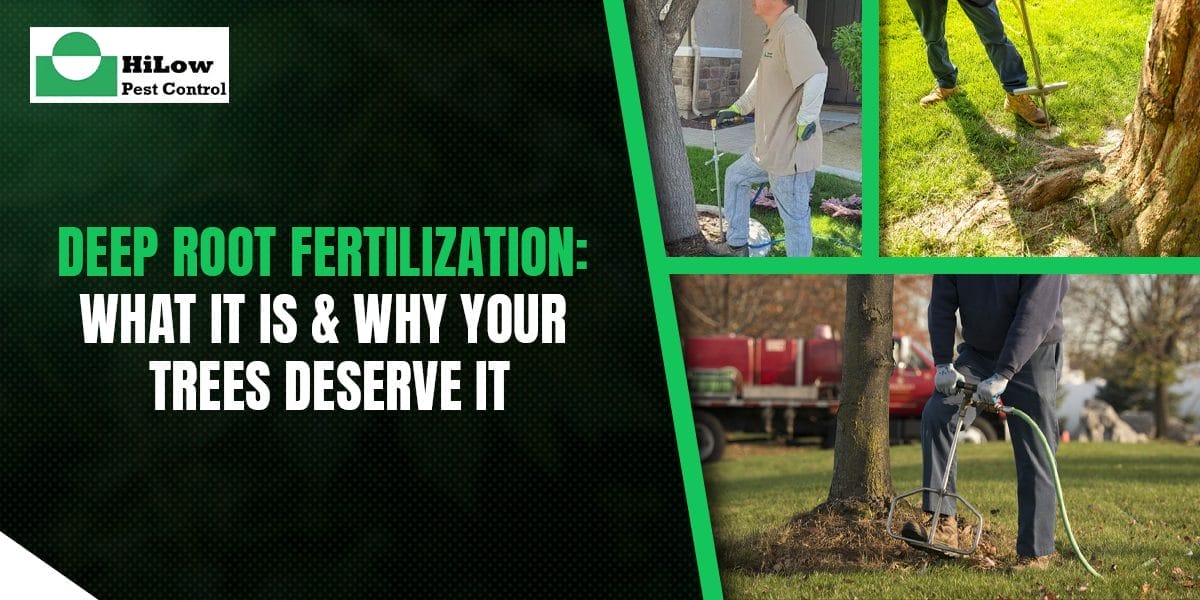Dull trees are depressing sights for any property owner. In a challenging climate like Nevada with high heat, limited moisture, and alkaline soil, your trees may need more than just regular care to thrive. This is where deep root fertilization comes in.
What Is Deep Root Fertilization? (Deep Root Tree Feeding)
Deep root tree fertilization (often called root feeding or deep root injection) is a way of delivering nutrients to your tree by injecting them directly into the soil using a specialized technique around the roots of the tree. This treatment uses high-pressure equipment to blend nutrients and organic matter into the soil of the tree.
It is injected roughly to a depth of 6-12 inches and around the tree in a grid manner. It makes sure all parts of the root zone receive enough nutrients.
Traditional vs. Deep Root Tree Fertilization
With standard tree fertilization, the nutrients are applied near the soil surface. However, many issues like soil compaction, crusting, or high pH can prevent those nutrients from reaching the feeder roots. Deep-root tree fertilization delivers the nutrients directly into the root areas where the tree can access them more efficiently.
Why It’s More Than Just “Feeding”
Deep-root tree fertilization does way more than just feeding nutrients to the trees.
- The injecting process helps aerate and loosen up the compacted soil. It improves root growth and oxygenation.
- It reduces nutrient runoff or leaching. It makes fertilization more environmentally friendly.
- It helps overcome barriers like soil crusting, alkaline topsoil, or turf competition. These factors block the nutrient movement downward.
- It is especially useful for trees that are under stress, like drought or disease.
Why Deep Root Fertilization Is Especially Important in Nevada
Nevada presents a challenging environment for trees to grow to their full potential. Soils are often alkaline (pH above 7.5), with high bicarbonates and low organic matter. The soil also has a tendency towards salinity. Coming to the climate, the rainfall is low, evaporation is high, and the water retention is limited. Here are several reasons why deep-root tree fertilization is critical:
- Poor surface nutrient availability: In high pH soil, many nutrients become insoluble near the surface. Therefore, it becomes unavailable to the roots. Supplying the nutrients deeper will improve intake.
- Salinity stress and salt burn: Fertilizers that are applied near the surface can contribute to salt near the root surface. It increases root burn in the dry soil. Root feeding puts the nutrients deeper, reducing salt concentration in the upper surface.
- Heat and drought stress: In extreme heat, trees struggle to absorb nutrients unless they have a good root system. Root feeding helps support deeper root growth that improves resilience in heat and drought.
- Compacted/urban soils: The landscape soils of Nevada are compacted, especially in urban or newly developed areas. It limits root penetration and water movement. The root feeder helps bypass the compaction.
The Benefits of Deep Root Fertilization
When properly done, root feeding offers more benefits than traditional methods. Some of these include:
Improved Nutrient Uptake
By delivering the nutrients where the feeder roots are, the nutrient uptake is faster and more improved. It also improves the foliage, color, and growth.
Improved Soil Structure and Aeration
The injection process causes micro-channels in the soil. It improves soil compaction and porosity. It helps with better water infiltration.
Stress Resistance
Well-nourished trees with deep-root feeding can better withstand drought, pests, disease, and environmental stressors.
Environmental Benefits and Reduced Leaching
Because nutrients are placed deeper into the soil, there are fewer chances of runoff or leaching. This makes the method more eco-friendly than traditional tree fertilization.
How Deep Root Fertilization Works: Process Overview
Here is a step-by-step overview of how the deep-root tree feeding process works. This will help you understand what deep root fertilization service contractors do (and DIYers lack):
-
Assessment and Soil/Tissue Testing
Before any fertilizer is applied to the soil, it is tested to see pH levels and salinity levels. Sometimes the leaf tissue is also tested together to look for nutrient deficiency.
-
Selecting the Appropriate Fertilizer Mix
Based on the test results, the appropriate mix of fertilizer is chosen. Professionals see whether it has macronutrients like N-P-K as well as essential micronutrients like iron, manganese, and zinc.
-
Choose Injection Depths and Spacing
The injectors are pushed 6-12 inches deep around the root zone, and often in a grid-like manner or radial pattern. The spacing and number of injection points required usually depend on the tree size as well as the soil profile.
-
Apply the Nutrient Solution
Using a high-pressure injection or specialized root feeder, a professional uses proper pressure to avoid root injury or soil rupture.
-
Monitor, Follow Up, and Adjust
After treatment, monitor the trees for weeks or months. Re-test the soil or foliage to track the nutrient absorption. Adjust the future fertilization programs accordingly.
Choosing the Best Fertilizer for Trees
Not all fertilizers are the same. Choosing the best fertilizer for trees is a crucial decision. It is often the main component that differentiates success and damage. The right one is usually tailored to the local soil chemistry and tree species.
Key considerations
- Solubility: The nutrients must dissolve and move easily through the injector equipment.
- Balanced N-P-K: You need to make sure the N-P-K balance meets local requirements.
- Micronutrients: Iron, zinc, manganese, copper, and boron are essential for a fertilizer in a high-pH soil.
- Coated or slow-release formulas: They can help avoid nutrient spikes.
- Acidifying or chelated forms: These types of micronutrients help with alkaline soil.
Customized Deep Root Fertilization
Here is why customized deep-root fertilization necessary for trees, especially the ones growing in difficult climate of Nevada.
- Using soil and leaf analysis to design a nutrient mix.
- Taking into consideration the species, age, stress level, soil pH, and local conditions.
- Adjusting dosage, micronutrient ratios, and timing.
- Monitoring response and updating future formulations.
- Integrating it with other tree health care practices like weed & vegetation control for more results.
Give Your Trees the Deep Care They Deserve
A tree is only as strong as its roots. True tree health begins below the ground. By taking care of the unseen root system with deep-root injection methods, you provide longevity in every tree you nurture.
Conclusion
At HiLow Pest Control, we believe every tree deserves the chance to thrive. We give your landscape a foundation of growth and health. With customized treatments that suit the unique soil of Nevada, we provide strategic and effective tree care to protect your investment.
Do not wait to see your tree struggle. Take action and call HiLow Pest Control.
Frequently Asked Questions about Deep-Root Fertilization:
Q1. Why is deep-root tree feeding necessary in Nevada?
A1. Nevada’s soil is dry and alkaline. So, it lacks key nutrients that are necessary. The root feeding process helps trees overcome these issues.
Q2. How often should I fertilize my trees?
A2. Most trees in Nevada require root feeding twice a year. It should ideally be around spring and fall.
Q3. Do I need professional deep root fertilization services?
A3. It is advised to seek professional help with root feeding, as they have a better idea of the right mix, pressure, and timing. They give you safe and effective results.


